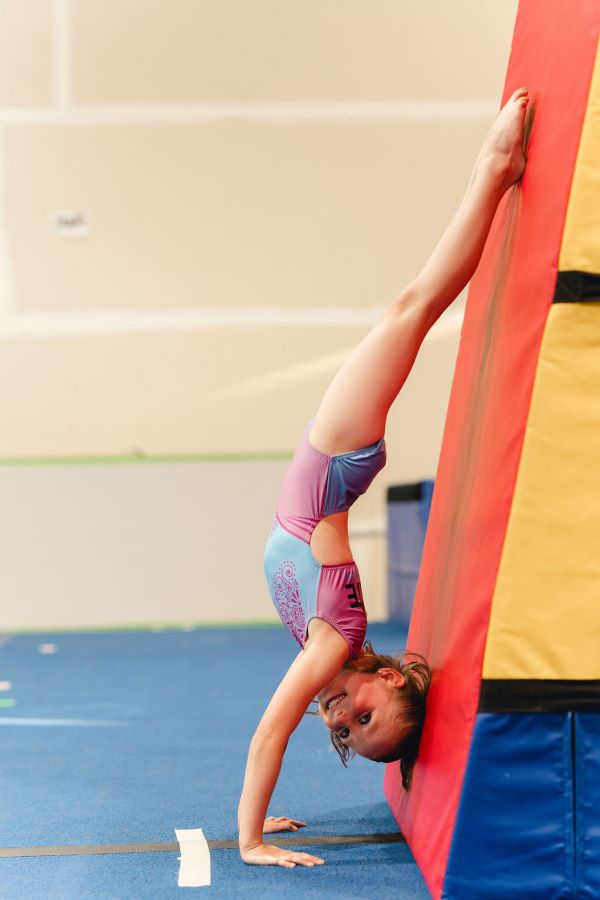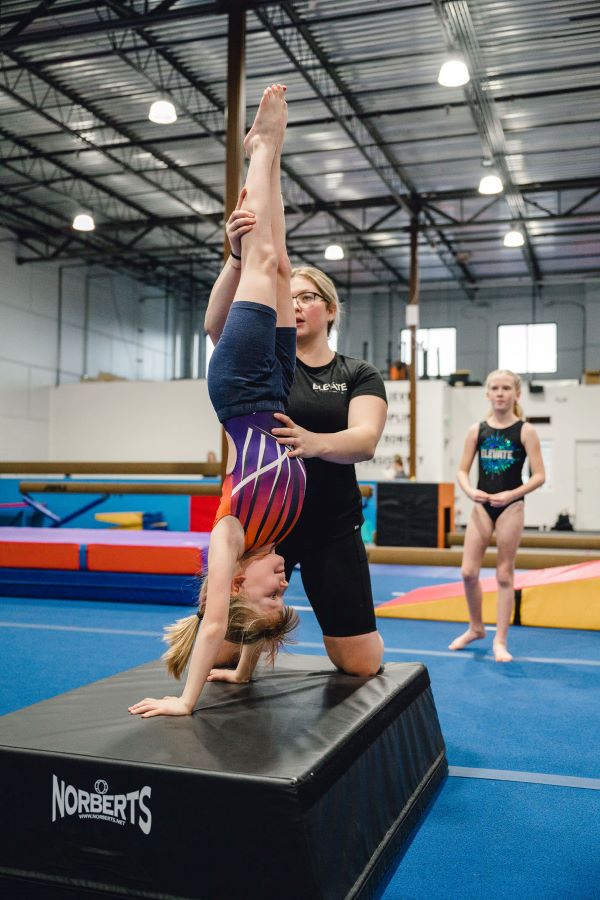The handstand is a cornerstone skill in gymnastics that lays the foundation for mastering other elements across the sport. A confident and well-executed handstand is vital for any gymnast. This skill not only enhances body control and balance but also strengthens the core, shoulders, and arms. It is the backbone for complex movements such as vaults, casts on bars, handsprings, and various beam skills. If you’re ready to enhance your gymnastics abilities, learning a steady handstand will be one of your first steps to success. Here’s a fun and easy guide to help you get started!
Step 1: Find Your Starting Position
The journey to a perfect handstand begins with the correct starting position. To get started simply standing in a lunge: place your dominant leg in front and your non-dominant leg extended slightly behind you for balance. Extend your arms overhead, keeping them about shoulder-width apart, palms facing forward. This position is not just a starting pose; it’s a fundamental posture that you will frequently return to as you begin practicing handstands at any level.
Why this position? It helps in distributing your weight evenly and aligns your body, making the subsequent steps into the handstand smoother and more controlled.
Step 2: Wall-Assisted Handstand
Before attempting a freestanding handstand, it’s crucial to build up your confidence and strength through wall-assisted practice. This method is safer for beginners and reduces the risk of injury.
- Positioning: Stand facing away from a padded wall. Bend forward to place your hands on the floor, shoulder-width apart. Gradually walk your feet up the wall until your body is in a straight line.
- Execution: Push through your shoulders and palms, keeping your body taut and aligned. Your head should be in a neutral position, eyes looking back at the wall. This position helps you feel the correct handstand alignment without the balance component overwhelming you.
Advancing the difficulty: As you become more comfortable, start to move your hands closer to the wall. This will shift your body into a more vertical line and increase the balance challenge.

Step 3: Practicing the Kick-Up
Transitioning from a wall-assisted handstand to kicking up into a handstand is a significant step. This move focuses on finding the right momentum and using your body weight to help lift you into the vertical position.
To get started kicking up, return to your lunge position, this time facing the wall. Lean forward, placing your hands on the ground, and smoothly kick your back leg upwards. The goal is to lift both legs into the air one at a time, using the wall to catch your feet if necessary.
Pro Tip: Start with gentle kicks to avoid crashing into the wall. As your control improves, increase the force of your kick to fully extend into the handstand.
Step 4: Achieving Balance and Control
Once you can kick up into a handstand and maintain it with the wall’s assistance, the next challenge is to do so without any support. This stage focuses on refining your balance and the ability to correct mid-air adjustments.
Quick Balancing Tips:
- Spread your fingers out as wide as you can and use them to help balance yourself
- Keep your body tight and balanced directly upward, and avoid leaning as best as you can
- If you are starting to fall forward or backward you can walk on your hands to catch yourself
Tracking your progress by setting a timer during your handstand practice can be highly motivating. Challenge yourself to hold the position longer each session and beat your personal record.

Beyond the Basics: Advanced Handstand Techniques
After mastering a basic handstand, you can explore more dynamic and challenging variations:
- Handstand Walking: This not only looks impressive but also significantly enhances your balance and body awareness.
- Handstand Push-Ups: Incorporate these into your routine to build upper body strength.
- Freestyle Moves: Experiment with leg positions, such as splits or scissor kicks, while in a handstand to add flair and difficulty to your routine.
Final Thoughts and Tips for Practice
Consistent practice is crucial for mastering the handstand. Incorporate these exercises into your regular training schedule, observe others (either in person or through online tutorials), and always seek feedback from coaches. Ensure your practice area is safe, with plenty of padding to prevent injuries from falls.
By dedicating time and effort to your handstand practice, you’ll not only improve your skills in gymnastics but also gain significant improvements in strength, balance, and overall body awareness. Remember, patience and persistence are your best tools on this journey. We hope you enjoy your time practicing and improving your handstands!
Try it FREE!
We offer one free trial class to all students who are interested in our programs. From NinjaZone to Tumbling, give one of our classes are shot. After all…. it’s FREE!


